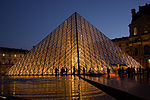Louvre Palace

The Louvre Palace (French: Palais du Louvre, [palɛ dy luvʁ]), often referred to simply as the Louvre, is an iconic building of the French state located on the Right Bank of the Seine in Paris, occupying a vast expanse of land between the Tuileries Gardens and the church of Saint-Germain l'Auxerrois. Originally a military facility, it has served numerous government-related functions in the past, including intermittently as a royal residence between the 14th and 18th centuries. It is now mostly used by the Louvre Museum, which first opened there in 1793. Whereas the area had been inhabited for thousands of years, the Louvre's history starts around 1190 with its first construction as a fortress defending the western front of the Wall of Philip II Augustus. The Louvre's oldest section still standing above ground, its Lescot Wing, dates from the late 1540s, when Francis I started the replacement of the medieval castle with a new design inspired by classical antiquity and Italian Renaissance architecture. Most parts of the current building were constructed in the 17th and 19th centuries.For more than three centuries, the history of the Louvre has been closely intertwined with that of the Tuileries Palace, created to its west by Catherine de' Medici in 1564 and finally demolished in 1883. The Tuileries was the main seat of French executive power during the last third of that period, from the return of the King and his court from Versailles in October 1789 to the Paris Commune which decided to burn it down in its final days in May 1871. The Pavillon de Flore and Pavillon de Marsan, which used to respectively mark the southern and northern ends of the Tuileries, are now considered part of the Louvre Palace. The Carrousel Garden, first created in the late 19th century in what used to be the great courtyard of the Tuileries (or Cour du Carrousel), is now considered part of the Tuileries Garden. A less high-profile but historically significant dependency of the Louvre was to its immediate east, the Hôtel du Petit-Bourbon, appropriated by the monarchy following the betrayal of the Constable of Bourbon in 1523 and mostly demolished in October 1660 to give way to the Louvre's expansion.: 37 The last remains of the Petit-Bourbon were cleared in the 1760s.
Excerpt from the Wikipedia article Louvre Palace (License: CC BY-SA 3.0, Authors, Images).Louvre Palace
Rue Saint-Honoré, Paris 1st Arrondissement (Paris)
Geographical coordinates (GPS) Address Nearby Places Show on map
Geographical coordinates (GPS)
| Latitude | Longitude |
|---|---|
| N 48.861111111111 ° | E 2.3363888888889 ° |
Address
Musée du Louvre
Rue Saint-Honoré
75001 Paris, 1st Arrondissement (Paris)
Ile-de-France, France
Open on Google Maps











